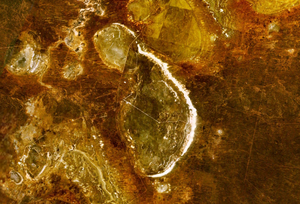- Lake Mungo
-
For the film, see Lake Mungo (film).
 Landsat 7 imagery of Lake Mungo. The white line defining the eastern shore of the lake is the sand dune, or lunette, where most archaeological material has been found
Landsat 7 imagery of Lake Mungo. The white line defining the eastern shore of the lake is the sand dune, or lunette, where most archaeological material has been found
 The shore of Lake Mungo.
The shore of Lake Mungo.
Lake Mungo is a dry lake in south-western New South Wales, Australia. It is located about 760 km due west of Sydney[1] and 90 km north-east of Mildura. The lake is the central feature of Mungo National Park, and is one of seventeen lakes in the World Heritage listed Willandra Lakes Region. Many important archaeological findings have been made at the lake, most significantly the discovery of the remains of Mungo Man, the oldest human remains found in Australia[2], and Mungo Lady, the oldest human remains in the world to be ritually cremated.
Geology
Sediments at Lake Mungo have been deposited over more than 100,000 years. On the eastern shore of the lake are the 'Walls of China', a 26 km long series of lunettes, about thirty metres high, formed over thousands of years. There are three distinct layers of sands and soil forming the Walls. The oldest is the reddish Gol Gol layer, formed between 100,000 and 120,000 years ago. The middle greyish layer is the Mungo layer, deposited between 50,000 and 25,000 years ago. The most recent is the Zanci layer, which is pale brown, and was laid down mostly between 25,000 and 15,000 years ago.
The Mungo layer, which was deposited before the last ice age period, is the most archaeologically rich. Although the layer corresponded with a time of low rainfall and cooler weather, more rainwater ran off the western side of the Great Dividing Range during that period, keeping the lake full. It supported a significant human population, as well as many varieties of Australian megafauna.
During the last ice age period, the water level in the lake dropped, and it became a salt lake. This made the soil alkaline, which helped to preserve the remains left behind in the Walls of China. Although the lake completely dried up several thousand years ago, ground vegetation remained on the Walls, which helped to stabilise them and preserve them. With the arrival of European settlers in the area since the 1880s, introduced species, notably rabbits and sheep, have destroyed the vegetation cover. Herds of feral goats are also present in the region. This has led to increased erosion of the dunes. However, this erosion has led to the uncovering of many human and animal remains. Wind has moved sand and soil eastwards from the Walls, forming a mobile sand dune which moves further east every year.
Archaeology
The most important findings at Lake Mungo have been Mungo Man and Mungo Lady. Mungo Lady, a partially cremated body, was discovered in 1969 by Dr Jim Bowler from the Australian National University (ANU). She was initially estimated to be 25,000 years old, although a more recent multi-university study in 2003 determined that she was probably closer to 40,000 years old. Mungo Lady is thus the earliest known human to have been cremated. Mungo Man was also discovered by Dr Bowler, on 26 February 1974. The remains were covered with red ochre, in what is the earliest known incidence of such a burial practice. Although some studies have estimated his age at more than 60,000 years, the current consensus is that he is also about 40,000 years old.
There is evidence of human habitation of the area around Lake Mungo that is as much as 50,000 years old. Stone tools have been found in the dunes which are older than the Mungo Man. Grinders for making flour have been found which are estimated to be between 5,000 and 10,000 years old; they were made of sandstone sourced from the Murray River basin 100 km away. A stone axe head, estimated to be at least 500 years old, was also found in the dunes; it was made from stone from Mount Camel, near Shepparton, well over 300 km away.
The poor archaeological heritage of the site is very significant to the Aboriginal Australian people from the area. The Willandra region is inhabited by the Barkindji, Nyiampaa and Mutthi Mutthi peoples, who have now entered Joint Management Agreements with the Government of New South Wales to manage the lake and the Mungo National Park.
References
- ^ "Distance calculator Sydney to Lake Mungo". Geoscience Australia. http://www.ga.gov.au/bin/distancedraw2?rec1=106743&placename=Sydney&placetype=0&state=NSW&place1=LAKE+MUNGO&place1long=143.001205&place1lat=-33.665199. Retrieved 2008-03-27.
- ^ New age for Mungo Man, new human history : Media Releases : News : The University of Melbourne
Categories:- Lakes of New South Wales
- Australian archaeology
- Archaeological sites in Australia
- Paleoanthropological sites
- Pleistocene paleontological sites of Australia
Wikimedia Foundation. 2010.
